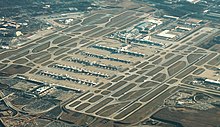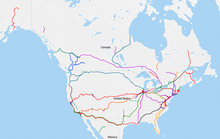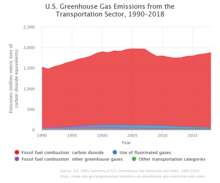Transportation in the United States
Most cargo in the U.S. is transported by, in descending order, railroad, truck, pipeline, or boat; air shipping is typically used only for perishables and premium express shipments.Canals swiftly took the role of turnpikes, stagecoaches, and wagon routes, which in turn were shortly replaced by steam-powered riverboats.These marginal rail routes survived the pricing pressures of competition, or the lack of revenue generated by low traffic, as long as railroads provided the only efficient economical way to move goods and people across the United States.The advent of the automobile signaled the end of railroads as the predominant transportation for people and began a new era of mobility in the United States.The scarcity of industrial materials during World War II slowed the growth of automobile manufacturing briefly and contributed to the nation's declining rail network.[17] The airline industry began to successfully compete with intercity rail as a result of government investment, which suffered a loss of ridership.Technological advances ushered in the jet age, which increased airline capacity, while decreasing travel times and the cost of flights.The costs of flying rapidly decreased intercity rail ridership by the late 1960s to a point where railroads could no longer profitably operate networks of passenger trains.This loss of business, when combined with the highly regulated operating environment and constrained pricing power, forced many railroads into receivership and the nationalization of several critical eastern carriers into the Consolidated Rail Corporation (Conrail).In the 1990s, the increase in foreign trade and intermodal container shipping led to a revival of the freight railroads, which have effectively consolidated into two eastern and two western private transportation networks: Union Pacific and BNSF in the west, and CSX and Norfolk Southern in the east.[18] Wartime expediency encouraged long distance pipeline transport of petroleum and natural gas, which was greatly expanded in the middle 20th century to take over most of the domestic long-haul market.With the development of the extensive Eisenhower Interstate Highway System in the 1950s, both long distance trips and daily commutes were mostly by private automobile.The system, as of 2010[update], has a total length of 47,182 miles (75,932 km),[25] making it the world's second longest after China's, and the largest public works project in US history.The vast majority of long-distance travel, whether for vacation or business, is by the national road network;[28] of these trips, about one-third (by the total number of miles driven in the country in 2003) utilize the Interstate system.The trucking industry provides an essential service to the American economy by transporting large quantities of raw materials, works in process, and finished goods over land—typically from manufacturing plants to retail distribution centers.Trucks in America are responsible for the majority of freight movement over land, and are vital tools in the manufacturing, transportation, and warehousing industries.The FMCSA is also a division of the United States Department of Transportation (USDOT), which governs all transportation-related industries such as trucking, shipping, railroads, and airlines.Private intercity rail ended in the United States in 1983 with the discontinuation of the Rio Grande Zephyr, until Brightline started in South Florida in 2018.Nearly all railroad corridors not including local transit rail systems are owned by private companies that provide freight service.Fishing and pleasure boats are numerous, and passenger service connects many of the nation's islands and remote coastal areas, crosses lakes, rivers, and harbors, and provides alternative access to Alaska which bypasses Canada.Freight on the Mississippi River system is carried on barges pushed by approximately 8000 "towboats" and largely consists of bulk goods, such as petrochemicals, grain and cement.[53] Automobile ferries operate in many locations where bridges are impractical and in congested metropolitan areas, including New York City and San Francisco Bay.[56] The federal military has a dedicated system of bases with runways, aircraft, watercraft, conventional cars and trucks, and armored and special-purpose vehicles.A key component of a suitable urban environment is support for pedestrian traffic, including people on foot as well as human propelled vehicles like bikes, skateboards, and scooters.Such efforts has been taken in different cities in California[64] and in September 2023 the state abolished the requirement of minimum parking space "within a half-mile of major public transit stops".Federal funding for highway, rail, bus, water, air, and other forms of transportation is allocated by Congress for several years at a time.The current authorization bill is the Safe, Accountable, Flexible, Efficient Transportation Equity Act: A Legacy for Users (SAFETEA-LU), which runs from 2005 to 2009.[69][needs update] Though earmarks are often made for specific projects, the allocation of most federal dollars is controlled by metropolitan planning organizations (MPOs) and state governments.State governments are sovereign entities which use their powers of taxation both to match federal grants, and provide for local transportation needs.[80] In a report conducted by the United States Environmental Protection Agency, an amount of 1.8 billion metric tons of carbon dioxide was emitted by the transportation sector in 2019.







Passenger trains in
North America







Total corn production (
bushels
) (left)
Corn used for
Ethanol fuel
(bushels) (left)
Percent of corn used for Ethanol (right)

Economy of the United StatesEconomic historyAgricultural historyBanking historyPetroleum historyShipbuildingIndustrial Revolution in the United StatesHistory of the United States dollarLumber historyTariff HistorySectorsPrimary sectorAgricultureEnergyPetroleumElectricity MiningFishingForestryWater and sanitationSecondary sectorAutomotiveIron and steelPulp and paperTertiary sectorSocial programsTransportationTourismEducationGamblingHealthcareInsuranceFinancial servicesCentral bankBankingLargest banksLargest companiesCaliforniaNew YorkFloridamore...State budgetsState credit ratingsState unemployment rateUnion membershipAllentownAtlantaBuffaloChicagoClevelandColumbusDetroitDoor CountyHoustonIndianapolisKansas CityLexingtonLong IslandLouisvilleMemphisNew York CityNorfolkPhiladelphiaPhoenixPittsburghSalt Lake CitySan DiegoSpokaneSt. LouisStamfordYoungstownWashington, D.C.Labor LawChild laborLabor unionsMinimum wageRight-to-work law UnemploymentCausesair shippinggreenhouse gas emissions in the United Statesnational parksInterstate Highway Systemprivate highways in the United Statesprivate roadsTransportation Security AdministrationU.S. Department of TransportationU.S. Department of Homeland Securityits own Department of TransportationAviation lawU.S. federal governmentunorganized territoriestidelandsUnited States Coast GuardPassenger vehiclesmotorcyclesTrucksTransitAmtrakferryboatspassenger-milesplanestrainsNortheast CorridorBicycle usageAmerican Community Surveybicycle commutingFreight transportationparcelsintermodalton-milescontainersUnited States Postal ServiceInterstate-HighwaysHighwaysRailwaysInland waterwaysTransportation safety in the United StatesEastern WashingtonAtlantic coastriverboatBoston Post RoadBostonturnpikesErie CanalIndustrial revolution

